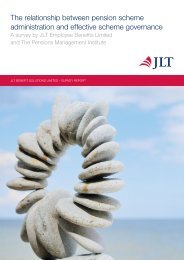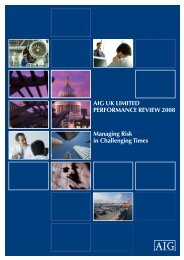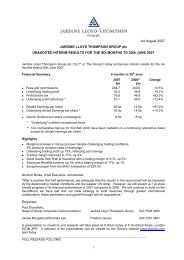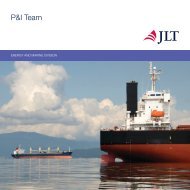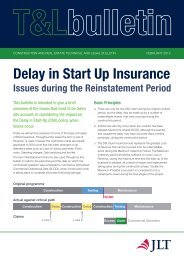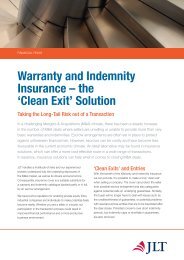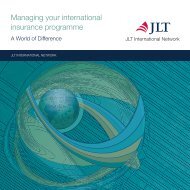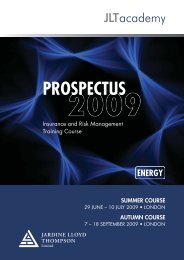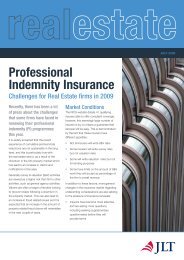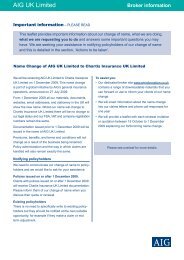Report & Accounts - JLT
Report & Accounts - JLT
Report & Accounts - JLT
- No tags were found...
You also want an ePaper? Increase the reach of your titles
YUMPU automatically turns print PDFs into web optimized ePapers that Google loves.
In addition, the adoption of IFRS 3 and IAS 38 requires that the Group recognise as intangible assets, separately from goodwill, anyassets acquired through a business combination that meet the criteria for an intangible asset as defined in IAS 38. Any intangibleasset recognised in this way is amortised to the income statement over its expected economic life. This is applicable foracquisitions completed after 1st January 2004.The Group has taken advantage of certain exemptions allowed in IFRS 1 as follows:The recording of net exchange differences into the Exchange Reserve required by IAS 21 has been applied prospectively from 1stJanuary 2004; all exchange differences arising prior to that date remain within retained earnings.IAS 32 and 39 have been applied on a prospective basis from 1st January 2005; as a consequence, no restatement of the 2004results has been made in respect of these standards. The impact of adoption on the opening balance sheet at 1st January 2005has been presented in note 1 on page 59.Accounting for share-based payments as required by IFRS 2 has been applied prospectively from 1st January 2004: norestatement has been made for any cost that would have arisen prior to that date.Basis of consolidationThe consolidated financial statements comprise the accounts of the Company and its subsidiary undertakings. The profits andlosses of subsidiary undertakings are consolidated as from the effective date of acquisition or to the effective date of disposal.a) SubsidiariesSubsidiaries are all entities over which the Group has the power to govern the financial and operating policies so as to obtaineconomic benefits and generally accompanying a shareholding of more than one half of the voting rights. The existence andeffect of potential voting rights that are currently exercisable or convertible are considered when assessing whether the Groupcontrols another entity. Subsidiaries are fully consolidated from the date on which control is transferred to the Group. They arede-consolidated from the date that control ceases.The Group uses the purchase method of accounting to account for the acquisition of subsidiaries. The cost of an acquisition ismeasured, as the fair value of the assets given, equity instruments issued and liabilities incurred or assumed at the date ofexchange, plus costs directly attributable to the acquisition. Identifiable assets acquired and liabilities and contingent liabilitiesassumed in a business combination are measured initially at their fair values at the acquisition date, irrespective of the extent ofany minority interest. The excess of the cost of acquisition over the fair value of the Group’s share of the identifiable net assetsacquired is recorded as goodwill. If the cost of acquisition is less than the fair value of the net assets of the subsidiaryacquired, the difference is recognised directly in the income statement.Inter-company transactions, balances and unrealised gains on transactions between Group companies are eliminated.Unrealised losses are also eliminated unless the transaction provides evidence of an impairment of the asset transferred.Accounting policies of subsidiaries have been changed where necessary to ensure consistency with the policies adopted bythe Group.b) AssociatesAssociates are all entities over which the Group has significant influence but not control, generally accompanying ashareholding of between 20% and 50% of the voting rights. Investments in associates are accounted for by the equity methodof accounting and are initially recognised at cost.The Group’s investment in associates includes goodwill (net of any accumulated impairment loss) identified on acquisition.The Group’s share of its associates’ post-acquisition profits or losses are recognised in the income statement, and its share ofpost-acquisition movements in reserves are recognised in reserves. The cumulative post-acquisition movements are adjustedagainst the carrying amount of the investment.When the Group’s share of losses in an associate equals or exceeds its interest in the associate, including any otherunsecured receivables, the Group does not recognise further losses, unless it has incurred obligations or made payments onbehalf of the associate.Unrealised gains on transactions between the Group and its associates are eliminated to the extent of the Group’s interest inthe associates. Unrealised losses are also eliminated unless the transaction provides evidence of an impairment of the assettransferred. Accounting policies of associates have been changed where necessary to ensure consistency with the policiesadopted by the Group.Financial Statements Jardine Lloyd Thompson Group plc Annual <strong>Report</strong> & <strong>Accounts</strong> 200551



